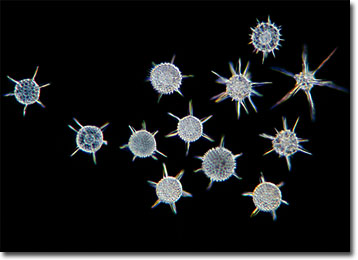Wim van Egmond
Radiolaria
Radiolaria are single-celled marine organisms belonging to the phylum Actinopoda that generally absorb silicon compounds from their environment to create beautiful, glasslike exoskeletons called tests. The radiolaria most commonly observed are spherical or cylindrical in shape, but occasionally microscopists discover more unusual forms, such as the stunning, star-shaped radiolaria presented below.

The tests of radiolaria are renowned for their elaborate designs composed of pores, plates, spines, and spicules. Perforations in the tests enable the protozoa to extend pseudopodia outside of their skeletons in order to facilitate capture of diatoms, copepods, and other food particles, while a central casing composed of chitin sheaths the nuclei and partitions the cytoplasm into two sections. The outer section of the cytoplasm holds a number of vacuoles that help control the buoyancy of radiolaria. Reproduction of the organisms is asexual and may take place via binary or multiple fission, or through budding.
Typically, radiolaria are more familiar as skeletons than as living creatures. In fact, it was the discovery of ancient tests in the form of a large deposit of ooze along the ocean floor by the nineteenth century Challenger expeditions that first truly revealed their tremendous variation in design, as well as their unique splendor. Some of the hand-drawn illustrations produced from the samples obtained by the ship are so magnificent that they rival many of the photomicrographs of the microscopic creatures taken in modern times. However, radiolarian ooze is not only important for the hidden beauty it contains, but also for the fact that when parts of the ocean beds were raised and changed into terra firma, the substance became sedimentary rock, such as tripoli. Moreover, flint, chert, and other silica deposits derive from the skeletal remains of radiolaria.
BACK TO WIM VAN EGMOND GALLERY
